RARE Original PANERAI Swiss Watch Store Display Case Expositor Stand, 2015
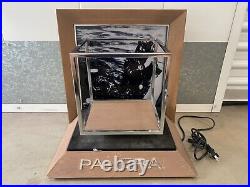
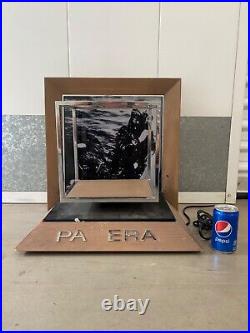


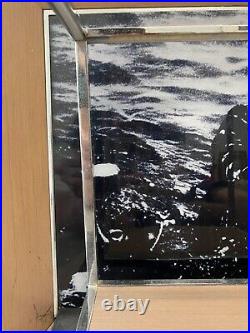
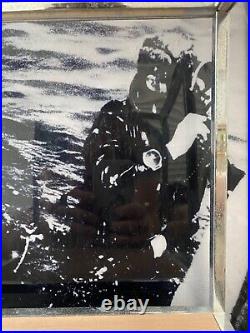
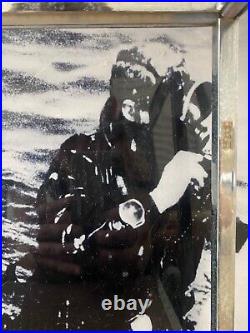














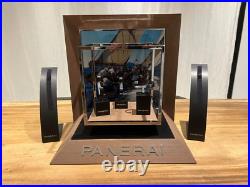

This is a seldomly seen on the market and RARE Original PANERAI Swiss Watch Store Display Case Expositor Stand, for Panerai Swiss wristwatches, which were used in Panerai stores, circa 2015. This display case is designed like a wooden clamshell box, with a metal cube in the center, and the black & white image of an ocean diver in the background, who comes up to the surface while prominently wearing a Panerai watch on his wrist.
The background image was originally illuminated by LED lights, however when I plugged this piece in, the backlighting appears to be non-functional in its current condition. This case would have been in the front window of the illustrious Panerai stores, which are in some of the finest retail shopping locations in the world, such as Geneva, Paris, and Abu Dabi. From the information I have gathered, this display case was used in 2015, and perhaps for some time afterward. It has the intended capacity to hold three wristwatches. Approximately 17 1/4 inches tall x 17 1/4 inches wide x 13 1/34 inches deep. Good condition for nearly a decade of age and storage, with mild - moderate scuffing, edge wear, dust, two missing appliqued letters on the front, a non-working LED backlight, etc. The back piece appears to be slightly loose on its connection points to the base please see photos. All of these issues could be easily fixed with a competent restorer or electrician. Photo 24 in this listing shows how this case once looked when it was in mint condition and on display in a Panerai store. Acquired in Los Angeles County, California.If you like what you see, I encourage you to make an Offer. Please check out my other listings for more wonderful and unique artworks! Have been referred to as "art in motion" and have become popular with the most discerning watch enthusiasts the world over. Learn more about Panerai's history as we take a deep dive into the brand's heritage. The concern known today as Officine Panerai.
Was established in Florence in 1860 -one year before the formation of the modern Italian state. At the time, its founder, Giovanni Panerai, established an office combining the functions of a watchmaking school, a repair workshop, and a sales showroom. Eventually assuming the name Orologeria Svizzera, the company soon became an influential point of sale for Swiss watches.The late nineteenth century saw Panerai enter a transitional period under Giovanni and his son, Leon Francesco. Father and son worked with recognized watch industry leaders from the Swiss horology heartland to establish supplier ties that became the basis for the Italian firm's sales growth and eventual watch production model. Movements, cases, specialized parts, and entire watches traveled from Swiss specialists to Panerai's offices as needed. Under Leon Francesco's guidance, Panerai diversified to become a research and development operation with core competencies in mechanical engineering, component fabrication, and instrument design.
This was no aberration; for most of its history, Panerai's professional tool and hardware fabrication would represent an important source of revenue for the company. ENTERING THE TWENTIETH CENTURY - 1900S.
By the turn of the twentieth century, Giovanni's grandson, Guido, had established the firm, then known as Guido Panerai & Figlio, as an official supplier to the Regia Marina, the Royal Italian Navy. Initially, the contracts focused on the company's burgeoning capabilities as a diversified design bureau. Timing and contact triggers for mines, submersible navigation tools, and mechanized computing devices represented the bulk of Panerai's early military contracts.
Critically, the turn of the twentieth century also set Panerai on a convergence course with the military watchmaking identity for which it became legendary. Between 1915 and 1916, Panerai worked to develop a self-sustaining source of illumination for the military equipment that was becoming central to the firm's business model. Marie and Pierre Curie's 1898 discovery of radium had opened a new field of technology designed to harness the gamma emissions of the new element.
Panerai's proprietary radium compound, composed of zinc sulphide, radium bromide, and mesothorium, was trademarked as Radiomir. THE EMERGENCE OF WATERPROOF WATCHES - 1920S. On a parallel plane of the watch industry, one of Panerai's Swiss manufacturing partners, Rolex, was making its name in the waterproof watch sector. Rolex's 1926 development of the "Oyster" case became a defining moment in the history of the watch industry.
Previously, "waterproof" (today known as "water resistant") watches were unreliable, awkwardly packaged, and economically impractical. With the development of Rolex's Oyster, waterproof watches became a practical proposition for consumer pocket and wrist models.
The arrival of waterproof watches also created a new sales proposition for one of Panerai's largest patrons: the Italian military. Italy's World War I success with combat swimmers combined with interwar development of the "Davis Rebreather, " a pioneering portable underwater breathing device, to spawn a new class of maritime combatant: the underwater demolition specialist, or frogman. Waterproof timers were essential to the success of the new concept, and in Radiomir. And the Rolex Oyster, Panerai held both keys to the Regia Marina's puzzle.WATCHES FOR THE ITALIAN NAVY - 1930S & 40S. By the mid 1930s, discussions between Panerai and Italian naval authorities had reached a critical mass.
2533 Oyster-cased pocket watches, complete with movements. By special consent of the Swiss firm, Panerai was permitted to modify the cases, movements, and dials to suit the demands of its military end-user. Between 1936 and 1938, the Panerai, Rolex, and Italian authorities collaborated to refine the model that would become the definitive Panerai military tool watch.
Between 1938 and 1956, these watches formed the backbone of Panerai's deliveries to the Italian Navy. All of the Panerai watches were assembled by Rolex, and Panerai's. Italian office modified them to suit military requirements. Soldered-on wire lugs, waxed leather straps, high-visibility dials with a two-piece "sandwich" construction, enlarged bezels, and a shatter-resistant crystal composed of a revolutionary thermoplastic compound, Plexiglas, became the signature contributions of the Italian contractor. World War II was the crucible in which Panerai watches' military legacy and combat heritage were forged.
The Italian amphibious commandos, having been consolidated under the unit banner "Decima Flottiglia Mezzi d'Assalto, " went to war equipped with Panerai watches and instruments. Combat operations with manned torpedoes (maiale), limpet mines, and explosive speedboats (barchini) succeeded in sinking Allied combatant and transport craft in the Mediterranean theater. Panerai's distinctive combat wristwatches accompanied all Decima personnel. Both the Panerai timepieces and Italian frogmen became influential in elite tactical circles.
The German navy adopted the Panerai, dubbed the "Kampfschwimmer, " as the timekeeper of choice for its own elite amphibious units. Understandably unable to source the Panerai product, the British Admiralty nevertheless worked to emulate both the Italian "Gamma" swimmers and their Panerai dive watches. In September of 1943, almost two years after the December 1941 Decima raid on Alexandria that crippled the HMS Queen Elizabeth and HMS Valiant, the Royal Navy conducted a virtually identical operation - down the watch specifications - that disabled the German battleship Tirpitz in its Norwegian berth. The modern era of elite tactical warfare and amphibious special forces had been born, and Panerai watches were to remain inextricably linked to this seminal moment in military history. Between the outbreak of war in Europe in 1939 and the full frost of the Cold War in the 1950s, Panerai produced a limited number of watches that gradually dovetailed the end of its military relationship with the groundwork for its eventual consumer success. During this period, the company continued to experiment with new lug designs, new cases, new models, new forms of locking crowns, and new chemical compounds for its signature illuminated dials.As Italian Fascism receded in the face of Allied onslaughts and milquetoast Italian enthusiasm for Mussolini's ethos, Panerai foresaw postwar openings for new domestic and foreign military contracts. While few of these efforts came to commercial fruition, they swelled a company product catalog that would underpin Panerai's millennial emergence as a consumer phenomenon. Design studies for an aborted chronograph project, the 1943 "Mare Nostrum, " helped to set the stage for the brand's eventual civilian debut. Wartime Italian efforts to improve upon the in-and-out wear vulnerability of Rolex's screw-down crown led to the first schematics of the "device protecting the crown, " a practical locking mechanism that would become the company's most iconic design element.
In the wake of the war and growing awareness of gamma radiation's health impact, Panerai moved to reformulate its glowing dial paint. The new luminescent chemistry, which was based on a beta ray emitter, tritium, debuted in prototype form in 1949.
The material was as notable for its name as its composition. Panerai's trademarked name for the substance, Luminor. Would live on long after the paint of the same name was phased out.
It is important to note that until the consumer era, the names Radiomir and Luminor exclusively referred to luminescent paint compounds, not case designs. During this period of low volumes and frequent experimentation, Panerai also accelerated its development of a case to replace the original shape inherited from Rolex's pocket watch line. In time, the Italians replaced the soldered wire lugs with integrated lugs machined into a one-piece case. The postponed upgrade to the Rolex screw-down crown first saw the light of day as a physical prototype in 1950, and the system was protected by patent in 1956. That year, Panerai incorporated the new crown in one of its last major developments as a military timepiece supplier.
PARTNERING WITH THE EGYPTIAN NAVY - 1950S. In conjunction with the Egyptian Navy, for which Panerai had previously developed tactical watches in 1953, the Italian contractor delivered a transitional model that incorporated distinctive elements from past and future Panerai products. The 60mm "Big Egiziano" featured a case that 21st century buyers would consider analogous to a modern Luminor Submersible, complete with rotating and calibrated bezel, integrated lugs, and a device protecting the crown. However, by special request of the Egyptian authorities, the watch also bears the distinction of being the final application of Panerai's original Radiomir radium compound. The end of the nineteen fifties also marked the end of Panerai's manufacturing arrangement with Rolex. From 1956, when the Rolex relationship officially ended, until 1972, the company's instrument arm entered a period of decline. That year, Giuseppe Panerai, Guido's son and the family scion who oversaw nearly the entire tactical watch program, died.A NEW ERA FOR PANERAI - 1970S-90S. A former Italian naval officer and engineer, Dino Zei, became the first non-Panerai to lead the company since its 1860 inception. From 1972 through the early 1990s, Zei directed the company to focus on remaining opportunities in the fields of dive tools, aerospace components, and radio equipment. With the exception of prototyping several pioneering titanium dive models, watchmaking activities effectively ceased. 1993 marked the dawn of the modern era for Officine Panerai.
Having assumed that name during the early Zei era, the one-time watchmaker realized that its military legacy could secure it a niche in the resurgent market for upscale mechanical watches. Having witnessed Rolex's emergence on the strength of its dive models, Panerai raided its back catalog of tactical products and prototypes to deliver the first branded consumer watches in the firm's 133-year history.
The three 1993 model-year watches unveiled on the Italian warship Durand De La Penne bore names from Panerai's military heritage. The first, a production simulacrum of the 1943 Mare Nostrum prototype, amounts to a footnote in modern Panerai history. However, the other two models, bearing the "Luminor". Imprint, became the basis for Panerai's breakthrough consumer product. Now a specific case design rather than a luminous paint, the name Luminor became synonymous with the 44mm case diameter, the Panerai crown protector, and the integrated lugs of the later military models.Initially, public reaction to the Panerai lineup was tepid. The limited commercial profile of the parent company, nearly non-existent distributor base, and minimal marketing combined to relegate the watches to immediate closeout items at the few vendors who took a chance.
Like the similarly outsized Audemars Piguet Royal Oak. Of the same year, Panerai's debut struggled to attract early adopters. Instead, the tonic for Panerai's marketing malaise came in the form of unpaid endorsements. Enamored of the look, Stallone placed a succession of mass orders for custom "Slytech" branded Luminors.These watches, which constituted Panerai's first volume orders, also proved to be a publicity boon for the company. Multiple unsponsored film appearances and sightings on the wrists of Stallone associates, including Arnold Schwarzenegger, raised the company's public profile sufficiently to jump-start initial consumer demand. By 1997, Panerai had a pulse. The company's incipient growth and emerging general market demand for mammoth dive watches convinced the Vendome Group - now Richemont, S. To take a low-risk gamble on Panerai.
Officine Panerai joined the Vendome fold. In doing so, it gained access to significant marketing, product development, and distribution resources. CONNECTING WITH PANERAI ENTHUSIASTS - 2000S. Between 1997 and 2014, virtually every feature of the present Officine Panerai customer base, brand image, and product line emerged.
Panerai was the first watch brand to benefit from the promotional power of the Internet. While the company's official web presence was merely par for its industry, it was the third party and user-generated content that drove the company's online buzz. Websites and web forums emerged as the focal points for collector interest in the Panerai products, model availability, and heritage of tactical exploits. Networked a fan base that amounted to several thousand individuals spread globally.
But their online ranks swelled, and the self-described "Paneristi" became the brand's best salesmen. Online users communicated what Vendome and its agents couldn't; Panerai's appeal lay in its historic ties to special forces, application-driven design, and unprepossessing image. Wearing a Panerai was like owning a memento of an adventure. Buyers who were leery of extrovert accessories per se appreciated the practical rationale behind the Luminor's standout size; the unpretentious image of a blue-collar working watch firewalled the Italian brand from the baggage occasionally associated with other upscale watch labels.And Richemont was happy to play along. In the intervening period, Panerai passed multiple milestones that continued its progression from military contractor to cult product to mainstream player. Under Richemont, Panerai's product focus remained robust and innovative. Frequent limited editions highlighted significant models, calibers, and episodes in the company's history.
Panerai packaging and supporting documents pioneered the concept of "correlation" whereby each authenticating document relies to an extent on another within the set. Richemont's early decision to include standard strap-changing tools and auxiliary straps enabled a budding accessory strap subculture to flourish within the Panerai owner community. Subsequent model releases capitalized on this trend by incorporating convenient quick-release lugs. A dedicated Neuchâtel production facility opened in 2002. In 2005, the same facility, now networked with Richemont's in-house Val Fleurier R&D arm, launched the Swiss-Italian firm's first exclusive movement, the Caliber P.
Additional 2000, 3000, 5000, and 9000 series calibers were launched featuring new combinations of complications and haut-de-gamme finish. As a nod to the past, occasional releases of new-old-stock historic movements have maintained Panerai's momentum and burnished its history-driven image. As the pedigree and prices of Panerai timepieces grew in magnitude, so did the model lineup. As early as 1997, the limited reissue of a model based on the template of Panerai's pre-war workhorse had received enthusiastic response from collectors. In order to better reflect company history and diversify the consumer offerings, Panerai developed a second major model line: the Radiomir. Based on the case shape and crown layout of the pioneering Panerai 3646 military model, the Radiomir joined the Luminor as the second pillar of the modern Panerai product catalog. Today, Panerai is owned by a wholly owned subsidiary of Compagnie Financière Richemont S.And offers a full line of watches based in varying degrees on its historic models. While the Luminor and Radiomir remain the core genus of each variant, Panerai has expanded its product scope to encompass precious metals, high horology complications, and case sizes that have ranged from 60 to 40mm.
Critically, the company's heritage has remained central to each new product launch. Prototypes and limited run features not seen since the 1940s and 50s continue to resurface with regularity. Among others, the original 47mm Rolex case of the 3646, the rotating dive bezel of the "Big Egiziano, " the titanium case of the 1980s "1000 Meter" prototype, and the monstrous form of the original Mare Nostrum chronograph have reemerged under Richemont guidance. While the volumes, distribution network, and public profile of Officine Panerai. Have grown to a level without precedent in brand history, it is this history above all else that remains essential to understanding the appeal of its watches.